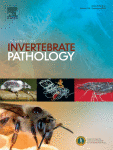View Item
- xmlui.general.dspace_homeCentros e Institutos de InvestigaciónCICVyA. Centro de Investigación en Ciencias Veterinarias y AgronómicasInstituto de Microbiología y Zoología AgrícolaArtículos científicosxmlui.ArtifactBrowser.ItemViewer.trail
- DSpace Home
- Centros e Institutos de Investigación
- CICVyA. Centro de Investigación en Ciencias Veterinarias y Agronómicas
- Instituto de Microbiología y Zoología Agrícola
- Artículos científicos
- View Item
Biological and molecular characterization of Rachiplusia nu single nucleopolyhedrovirus, a promising biocontrol agent against the South American soybean pest Rachiplusia nu
Abstract
Rachiplusia nu (Lepidoptera: Noctuidae) is a key soybean pest in Argentina. Current management of this moth
relies mainly on the use of synthetic insecticides and transgenic plants. In search of biological control-based
alternatives, a baculovirus from R. nu (hereafter RanuNPV) was characterized and its insecticidal properties
tested under laboratory conditions. RanuNPV occlusion bodies (OBs) were nearly tetrahedral, averaging
1.0 ± 0.2 μm in their
[ver mas...]
Rachiplusia nu (Lepidoptera: Noctuidae) is a key soybean pest in Argentina. Current management of this moth
relies mainly on the use of synthetic insecticides and transgenic plants. In search of biological control-based
alternatives, a baculovirus from R. nu (hereafter RanuNPV) was characterized and its insecticidal properties
tested under laboratory conditions. RanuNPV occlusion bodies (OBs) were nearly tetrahedral, averaging
1.0 ± 0.2 μm in their longest edge and containing singly enveloped nucleocapsids. Histopathology of infected
late-instar larvae revealed broad tissue tropism, where fat bodies and epidermis were the most affected organs.
Phylogenetic analysis of concatenated polh, lef-8 and lef-9 partial sequences classified RanuNPV as a new species
that clusters with other group II alphabaculoviruses infecting larvae of Plusiinae. Bioassays performed with R. nu
neonates determined the median lethal dosage to be approximately 2.5 OBs/larva; most insects died within
4–5 days post inoculation showing typical baculovirus-induced liquefaction. No effects were observed in other
lepidopteran species assayed, including Spodoptera frugiperda, Cydia pomonella and Diatraea saccharalis. High
pathogenicity and host specificity make RanuNPV a good candidate for controlling R. nu.
[Cerrar]

Author
Jakubowicz, Violeta;
Taibo, Catalina Beatriz;
Sciocco, Alicia Ines;
Arneodo Larochette, Joel Demian;
Fuente
Journal of invertebrate pathology 166 : 107211. (September 2019)
Date
2019-09
Editorial
Elsevier
ISSN
0022-2011
Formato
pdf
Tipo de documento
artículo
Palabras Claves
Derechos de acceso
Restringido
 Excepto donde se diga explicitamente, este item se publica bajo la siguiente descripción: Creative Commons Attribution-NonCommercial-ShareAlike 2.5 Unported (CC BY-NC-SA 2.5)
Excepto donde se diga explicitamente, este item se publica bajo la siguiente descripción: Creative Commons Attribution-NonCommercial-ShareAlike 2.5 Unported (CC BY-NC-SA 2.5)

